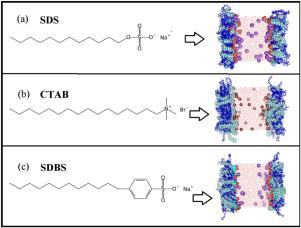当前位置:
X-MOL 学术
›
Colloids Surf. A Physicochem. Eng. Aspects
›
论文详情
Our official English website, www.x-mol.net, welcomes your
feedback! (Note: you will need to create a separate account there.)
Effect of Triton X-100 surfactant on the interfacial activity of ionic surfactants SDS, CTAB and SDBS at the air/water interface: A study using molecular dynamic simulations
Colloids and Surfaces A: Physicochemical and Engineering Aspects ( IF 4.9 ) Pub Date : 2020-10-01 , DOI: 10.1016/j.colsurfa.2020.125284 José G. Parra , Peter Iza , Hector Dominguez , Eduardo Schott , Ximena Zarate
Colloids and Surfaces A: Physicochemical and Engineering Aspects ( IF 4.9 ) Pub Date : 2020-10-01 , DOI: 10.1016/j.colsurfa.2020.125284 José G. Parra , Peter Iza , Hector Dominguez , Eduardo Schott , Ximena Zarate

|
Abstract Molecular dynamics simulations were carried out to investigate the effect of TX-100 surfactant on the interfacial activity of ionic surfactants SDS, CTAB and SDBS at the air/water interface. Here, interfacial properties, molecular orientation of hydrocarbon chains of ionic surfactant and radial distribution functions between hydrophilic headgroups and water molecules at the air/water interface was evaluated by means of MD simulations. Particularly, TX-100 surfactant produces a reduction of the interfacial film thickness obtained using the water layer and increases the hydrophobic film thickness of the systems. In this investigation, we found that TX-100 surfactant present in mixed monolayers and distributed randomly on the water surface can modify the hydrophilic-lipophilic balance of the monolayer increasing the hydrophobic film thickness and reducing the adsorption of ionic surfactants at the air/water interface. Furthermore, the molecular array of these mixed monolayers obtained by the TX-100 surfactant improve the elasticity of the liquid film, which avoid the rupture of foams reducing the liquid drainage velocity of these systems. Finally, the results suggest that hydrophobic film thickness of the mixed monolayers produce by the TX-100 surfactant can reduce the diffusion of gas molecules from air phase toward the water phase, which increase the stability of foams.
中文翻译:

Triton X-100 表面活性剂对离子表面活性剂 SDS、CTAB 和 SDBS 在空气/水界面的界面活性的影响:使用分子动力学模拟的研究
摘要 通过分子动力学模拟研究TX-100表面活性剂对离子表面活性剂SDS、CTAB和SDBS在空气/水界面的界面活性的影响。在这里,通过 MD 模拟评估了界面性质、离子表面活性剂的烃链的分子取向以及亲水头部基团和水分子在空气/水界面之间的径向分布函数。特别是,TX-100 表面活性剂降低了使用水层获得的界面膜厚度,并增加了系统的疏水膜厚度。在这次调查中,我们发现 TX-100 表面活性剂存在于混合单层中并随机分布在水表面可以改变单层的亲水亲油平衡,增加疏水膜厚度并减少离子表面活性剂在空气/水界面的吸附。此外,由TX-100表面活性剂获得的这些混合单分子层的分子排列提高了液膜的弹性,避免了泡沫破裂,降低了这些系统的液体排放速度。最后,结果表明TX-100表面活性剂产生的混合单分子层的疏水膜厚度可以减少气体分子从空气相向水相的扩散,从而增加泡沫的稳定性。TX-100表面活性剂获得的这些混合单分子层的分子排列提高了液膜的弹性,避免了泡沫的破裂,降低了这些系统的排液速度。最后,结果表明TX-100表面活性剂产生的混合单分子层的疏水膜厚度可以减少气体分子从空气相向水相的扩散,从而增加泡沫的稳定性。TX-100表面活性剂获得的这些混合单分子层的分子排列提高了液膜的弹性,避免了泡沫的破裂,降低了这些系统的排液速度。最后,结果表明TX-100表面活性剂产生的混合单分子层的疏水膜厚度可以减少气体分子从空气相向水相的扩散,从而增加泡沫的稳定性。
更新日期:2020-10-01
中文翻译:

Triton X-100 表面活性剂对离子表面活性剂 SDS、CTAB 和 SDBS 在空气/水界面的界面活性的影响:使用分子动力学模拟的研究
摘要 通过分子动力学模拟研究TX-100表面活性剂对离子表面活性剂SDS、CTAB和SDBS在空气/水界面的界面活性的影响。在这里,通过 MD 模拟评估了界面性质、离子表面活性剂的烃链的分子取向以及亲水头部基团和水分子在空气/水界面之间的径向分布函数。特别是,TX-100 表面活性剂降低了使用水层获得的界面膜厚度,并增加了系统的疏水膜厚度。在这次调查中,我们发现 TX-100 表面活性剂存在于混合单层中并随机分布在水表面可以改变单层的亲水亲油平衡,增加疏水膜厚度并减少离子表面活性剂在空气/水界面的吸附。此外,由TX-100表面活性剂获得的这些混合单分子层的分子排列提高了液膜的弹性,避免了泡沫破裂,降低了这些系统的液体排放速度。最后,结果表明TX-100表面活性剂产生的混合单分子层的疏水膜厚度可以减少气体分子从空气相向水相的扩散,从而增加泡沫的稳定性。TX-100表面活性剂获得的这些混合单分子层的分子排列提高了液膜的弹性,避免了泡沫的破裂,降低了这些系统的排液速度。最后,结果表明TX-100表面活性剂产生的混合单分子层的疏水膜厚度可以减少气体分子从空气相向水相的扩散,从而增加泡沫的稳定性。TX-100表面活性剂获得的这些混合单分子层的分子排列提高了液膜的弹性,避免了泡沫的破裂,降低了这些系统的排液速度。最后,结果表明TX-100表面活性剂产生的混合单分子层的疏水膜厚度可以减少气体分子从空气相向水相的扩散,从而增加泡沫的稳定性。





















































 京公网安备 11010802027423号
京公网安备 11010802027423号